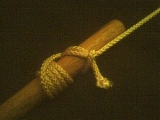
Icicle hitch
Encyclopedia
An icicle hitch is a knot
that is excellent for connecting to a post when weight is applied to an end running parallel
to the post in a specific direction. This type of hitch will hold its place even when holding a substantial load on a smooth surface. One can even suspend from a tapered post (such as a Marlin Spike
) with this knot (hence the name "icicle hitch").
To tie an icicle hitch bring the working end over the post, front to back, four or five times, working away from the end of the post (and the direction of expected pull). Bring the working end, back to front, alongside the standing end, leaving a substantial bight
hanging behind the post. Bring this bight over both ends, and over the end of the post. Tighten by pulling both ends perpendicular to the post. The pull on the standing end (running the direction of the post) will tighten the knot as more pull is given.
This knot is similar to the Prusik knot knot and the Klemheist knot. This class of knot is a "slip and grip" friction type that will pull tight when the load is applied in the correct direction and slide easily for placement with no load. The Prusik knot can withstand load in both directions, making it ideal for climbing situations. Upon examination of the icicle hitch, one finds that it operates under the same principle as the Klemheist knot and is in fact the same knot tied only with a bight in the end instead of the more common short loop used for climbing.
This knot was first demonstrated at the eighth Annual General Meeting of the International Guild of Knot Tyers
in 1990.
Knot
A knot is a method of fastening or securing linear material such as rope by tying or interweaving. It may consist of a length of one or several segments of rope, string, webbing, twine, strap, or even chain interwoven such that the line can bind to itself or to some other object—the "load"...
that is excellent for connecting to a post when weight is applied to an end running parallel
Parallel (geometry)
Parallelism is a term in geometry and in everyday life that refers to a property in Euclidean space of two or more lines or planes, or a combination of these. The assumed existence and properties of parallel lines are the basis of Euclid's parallel postulate. Two lines in a plane that do not...
to the post in a specific direction. This type of hitch will hold its place even when holding a substantial load on a smooth surface. One can even suspend from a tapered post (such as a Marlin Spike
Marlinspike
Marlinspike is a tool used in ropework for tasks such as unlaying rope for splicing, untying knots, forming a toggle , or forming a makeshift handle....
) with this knot (hence the name "icicle hitch").
To tie an icicle hitch bring the working end over the post, front to back, four or five times, working away from the end of the post (and the direction of expected pull). Bring the working end, back to front, alongside the standing end, leaving a substantial bight
Bight (knot)
In knot tying, a bight is a curved section, slack part, or loop between the two ends of a rope, string, or yarn. The term is also used in a more specific way when describing Turk's head knots, indicating how many repetitions of braiding are made in the circuit of a given knot.-Slipped knot:In order...
hanging behind the post. Bring this bight over both ends, and over the end of the post. Tighten by pulling both ends perpendicular to the post. The pull on the standing end (running the direction of the post) will tighten the knot as more pull is given.
This knot is similar to the Prusik knot knot and the Klemheist knot. This class of knot is a "slip and grip" friction type that will pull tight when the load is applied in the correct direction and slide easily for placement with no load. The Prusik knot can withstand load in both directions, making it ideal for climbing situations. Upon examination of the icicle hitch, one finds that it operates under the same principle as the Klemheist knot and is in fact the same knot tied only with a bight in the end instead of the more common short loop used for climbing.
This knot was first demonstrated at the eighth Annual General Meeting of the International Guild of Knot Tyers
International Guild of Knot Tyers
The International Guild of Knot Tyers is a world-wide association for people with an interest in knots and knot tying. Officially established in 1982, the founding members were initially drawn together by the 1978 publication in The Times of an allegedly new knot, the Hunter's bend.The goals of...
in 1990.

